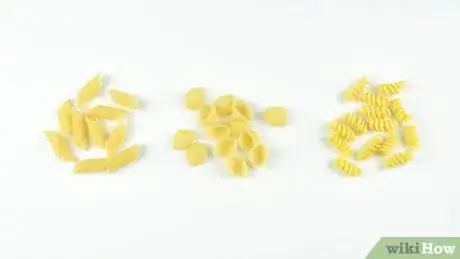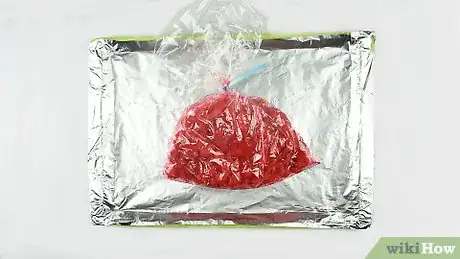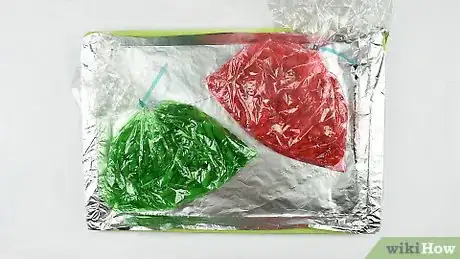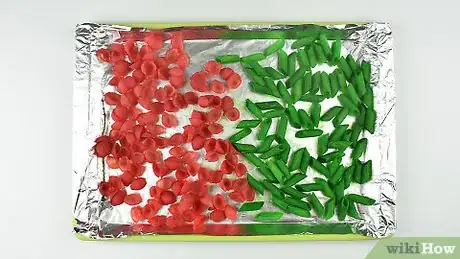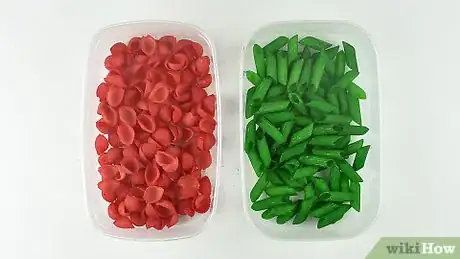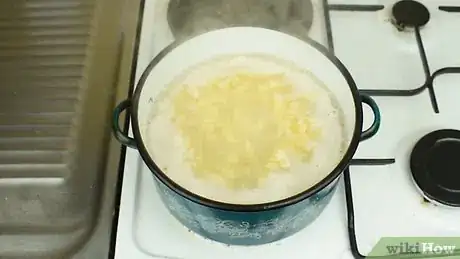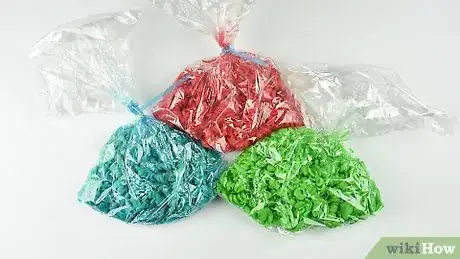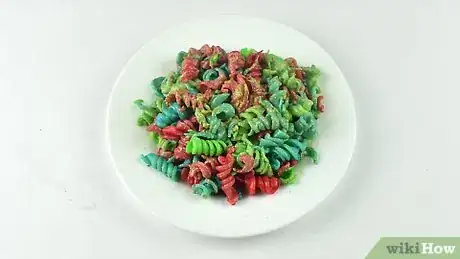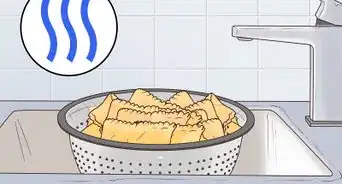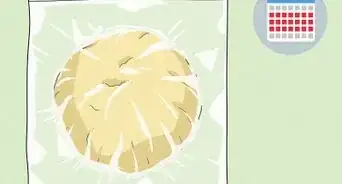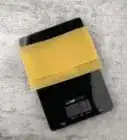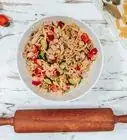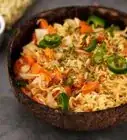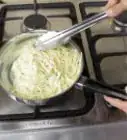This article was co-authored by wikiHow staff writer, Amber Crain. Amber Crain has been a member of wikiHow’s writing staff for the last six years. She graduated from the University of Houston where she majored in Classical Studies and minored in Painting. Before coming to wikiHow, she worked in a variety of industries including marketing, education, and music journalism. She's been a radio DJ for 10+ years and currently DJs a biweekly music program on the award-winning internet radio station DKFM. Her work at wikiHow supports her lifelong passion for learning and her belief that knowledge belongs to anyone who desires to seek it.
There are 10 references cited in this article, which can be found at the bottom of the page.
The wikiHow Video Team also followed the article's instructions and verified that they work.
This article has been viewed 26,651 times.
Learn more...
Dyed pasta is great to use in countless craft projects, and it’s also excellent for small children engaging in sensory play. Best of all, it’s so easy to make at home. All you need is rubbing alcohol, freezer bags, food coloring, and the dried pasta shapes of your choice. You can also make edible colored pasta, which is even easier and requires no alcohol or vinegar!
Steps
Dyeing Pasta for Crafts
-
1Select a variety of dried pasta shapes. Feel free to mix and match pasta shapes as much as you'd like. Having a variety of shapes is a great idea if you’re dyeing the pasta for sensory play. If you’re dyeing pasta for crafting, consider your project and use whatever shapes make sense to complete your vision.
-
2Divide the pasta into large, sealable freezer bags. Each bag will be for a different dye color, so if you’re planning to make 3 colors, fill 3 separate freezer bags with pasta. Make the plastic baggies fairly full, with 1-2 cups (100-200 grams) of dried pasta in each one.[3]
- Be sure to leave about 2 inches (5.1 cm) of headspace so you can move the pasta around and distribute the food coloring.
- Freezer bags are ideal because they seal tightly and are heavy-duty. If you only have regular baggies, though, you can use them.
Advertisement -
3Add 1 teaspoon (5 ml) of rubbing alcohol to your first bag of pasta. Measure out the rubbing alcohol and dump it over the pasta in the baggie. The ratio is approximately .25 cups (59 ml) of rubbing alcohol for every 1-2 cups (100-200 grams) of dried pasta. It’s best to work with one bag at a time and complete the process before moving on to the next bag/color.[4]
- If possible, use isopropyl alcohol with 70% concentration. Higher concentrations may cause stickiness and be harder to blend.
- You can substitute distilled white vinegar if you don’t want to use alcohol. Use 1 teaspoon (5 ml) of white vinegar.[5]
-
4Add 10 drops of food coloring to the first bag of pasta. If you want vibrant results, use a little more food coloring. If you’re going for pastel pasta, use a little less than 10 drops. You can use any color you want and even experiment with mixing colors to create new ones.[6]
- For example, mixing blue and red food coloring will result in purple dye.
- You can also use liquid watercolors instead of food coloring for this project, if you prefer. The results may be more vibrant.[7]
-
5Seal the freezer bag tightly and give it a good shake. Shake vigorously and massage the pasta with your hands so that the alcohol and food coloring are both distributed evenly throughout the bag. If the color isn’t coating the pasta adequately, feel free to add a little more food coloring or alcohol to the baggie.[8]
- Make sure the baggie is completely sealed before you start shaking to avoid making a mess!
-
6Keep the bag sealed and lay it out flat on a baking sheet. If you’re worried about leakage, line your baking sheet with aluminum foil before you start placing the bags on it. You’ll need enough baking sheets to lay all of your baggies out flat without stacking them.
-
7Follow the same process to create your other colors. Add 1 teaspoon (5 ml) of rubbing alcohol to the next bag and add the food coloring of your choice. Shake and massage the contents thoroughly and lay the baggie out flat next to the first one. Do the same for your remaining baggies.[9]
-
8Let the freezer bags lay flat for overnight. The longer you let the baggies sit, the more vibrant the colored pasta will be. Flip them over a few times during this time period to make sure the pasta soaks up the dye evenly.[10]
- Every time you flip the bags, take note of the vibrancy. You can stop soaking the pasta whenever it reaches your desired hue.
-
9Scatter the pasta on a flat surface and let it dry for 12 hours. Line a flat surface with newspaper or aluminum foil to avoid staining your surface. Dump the pasta from the freezer bags directly onto the newspaper. Scatter the pasta evenly in a single layer.[11]
- Avoid mixing colors at the point—keep a little space between each color.
-
10Use the dyed pasta or store it in an airtight container for future use. Your colored pasta is ready to use the next day! If you aren’t using the pasta right away, store it in an airtight container to preserve the color. The dyed pasta will be safe to use for crafts and sensory play indefinitely.
- Be sure to keep the storage container somewhere dry and cool to keep the pasta in good shape.[12]
Dyeing Edible Pasta
-
1Boil 1 pound (450 g) of dried pasta according to the directions. You can use any pasta shape you like for this! Bring a pot of water to boil, submerge your pasta, and follow the package directions to cook the noodles. Be sure to cook them completely, just as you normally would.[13]
- Note that 1 pound (450 g) of noodles will make 4 servings of colored pasta. You can adjust the amounts if you need to make more or less.
- Make the noodles al dente if you plan to warm them back up after dyeing them.
-
2Drain the cooked noodles and rinse them with cool water. Place a colander in your sink and pour the hot noodles and cooking water into it. Let the water drain away, then immediately rinse the noodles with cool water to halt the cooking process.[14]
- Let the noodles sit in the colander and continue draining as you prepare the food coloring.
-
3Add water and food coloring to resealable freezer bags for each color you want to make. Use 20 drops of food dye and 2 US tbsp (30 ml) of water in each bag. Food coloring usually comes in shades of red, orange, yellow, green, blue, and purple. You can choose any colors you want! Each freezer bag will create a different color, so if you want 4 different pasta colors, you’ll need 4 separate freezer bags.[15]
- If you want to make pastel noodles, use 10 drops of food coloring instead of 20.[16]
- You can also mix your own colors. For example, mix yellow and blue together to make your own green shade. Red and blue will make purple, and red and yellow will make orange.
-
4Divide the cooked pasta evenly into the freezer bags. You don’t have to be exact, but try to use about the same amount of pasta for each freezer bag. If you want one color to dominate the finished pasta, just add more pasta to the bag with that food coloring in it.[17]
-
5Seal the freezer bags and massage the contents with your hands. Be sure the zipper closure is sealed tightly before you get started to avoid making a mess! Then, gently massage the noodles with your hands to evenly distribute the dye mixture in each bag.[18]
-
6Let the bags sit undisturbed for 1 minute. Lay the bags flat on their sides and give them about 60 seconds to soak up the food coloring. If you’re worried about spillage, cover your work surface with newspaper or parchment paper first.[19]
- You can experiment with letting the noodles soak longer than 1 minute, but they likely won't get that much more vibrant.
-
7Transfer the pasta back to the colander and rinse it with cool water. Work with 1 color at a time. Unseal the bag and dump the noodles back into the colander. Rinse off the noodles with cool water to get rid of any extra food coloring and put them back in the original pot you cooked them in.[20]
- Do the same for the rest of the colors.
-
8Toss the colored pasta in the pot to combine the pasta and serve it. Using forks or tongs, move the colored pasta around in the pot so the different colored noodles mix together evenly, giving you a rainbow effect. You can then serve the pasta immediately with any sauce you like![21]
- The pasta shouldn't be totally cold after rinsing it quickly with cool water, but if you want the noodles to be hotter, toss them in a pot of boiling water for 60 seconds.[22]
Things You’ll Need
Dyeing Pasta for Crafts
- Dried pasta
- Rubbing alcohol or vinegar
- Large freezer bags
- Food coloring or liquid watercolors
- Baking sheet
- Aluminum Foil
- Newspaper
- Airtight storage containers
Dyeing Edible Pasta
- Dried pasta
- Large pot
- Food coloring
- Large freezer bags
- Colander
- Newspaper
- Tongs
References
- ↑ https://artfulparent.com/fun-with-dyed-pasta-part-i/
- ↑ http://www.learnplayimagine.com/2014/08/how-to-dye-pasta.html
- ↑ https://artfulparent.com/fun-with-dyed-pasta-part-i/
- ↑ https://artfulparent.com/fun-with-dyed-pasta-part-i/
- ↑ http://parentingchaos.com/dye-pasta/
- ↑ https://www.cbc.ca/parents/play/view/play_date_idea_pasta_necklaces
- ↑ http://www.learnplayimagine.com/2014/08/how-to-dye-pasta.html
- ↑ https://www.cbc.ca/parents/play/view/play_date_idea_pasta_necklaces
- ↑ https://artfulparent.com/fun-with-dyed-pasta-part-i/
- ↑ https://artfulparent.com/fun-with-dyed-pasta-part-i/
- ↑ https://www.kidspot.com.au/things-to-do/activity-articles/make-coloured-pasta-jewellery/news-story/4628efd2d7aba9244b24f4d894c6dc9a
- ↑ https://happyhooligans.ca/dye-pasta-easy-way/
- ↑ https://www.tablespoon.com/recipes/rainbow-pasta/d7cb2f45-dea6-43e7-893f-6708e2dc10ec
- ↑ https://www.tablespoon.com/recipes/rainbow-pasta/d7cb2f45-dea6-43e7-893f-6708e2dc10ec
- ↑ https://www.tablespoon.com/recipes/rainbow-pasta/d7cb2f45-dea6-43e7-893f-6708e2dc10ec
- ↑ https://www.geniuskitchen.com/recipe/halloween-pasta-440711
- ↑ https://www.tablespoon.com/recipes/rainbow-pasta/d7cb2f45-dea6-43e7-893f-6708e2dc10ec
- ↑ https://www.tablespoon.com/recipes/rainbow-pasta/d7cb2f45-dea6-43e7-893f-6708e2dc10ec
- ↑ https://www.tablespoon.com/recipes/rainbow-pasta/d7cb2f45-dea6-43e7-893f-6708e2dc10ec
- ↑ https://www.tablespoon.com/recipes/rainbow-pasta/d7cb2f45-dea6-43e7-893f-6708e2dc10ec
- ↑ https://www.geniuskitchen.com/recipe/halloween-pasta-440711
- ↑ http://dish.allrecipes.com/pasta-cooking-basics/
About This Article
To make dyed pasta for a craft project, start by filling 3 sealable freezer bags with 1 to 2 cups of pasta each, leaving about 2 inches of headspace for you to move the pasta around. Once your pasta is bagged, add 1 teaspoon of rubbing alcohol and 10 drops of food coloring to the first bag. If possible, use isopropyl alcohol with 70% concentration, since higher concentrations can make your pasta sticky. After adding your color of choice, seal the freezer bag and give it a good shake until the pasta is fully covered. Next, place the baggie on a baking tray lined with aluminum foil and repeat the process with different colors for the other 2 bags. Then, let the pasta sit in their bags overnight before scattering across the baking tray to dry for 12 hours. For more advice, like how to make edible dyed pasta, read on!
